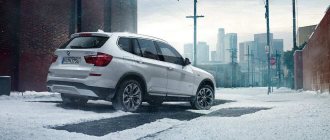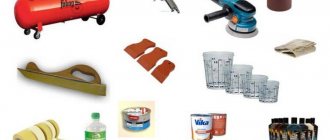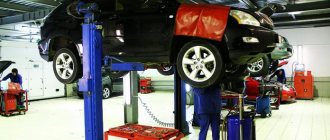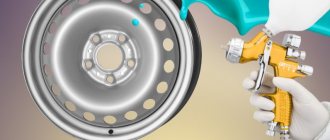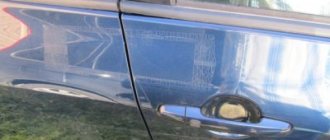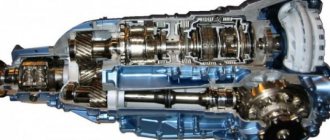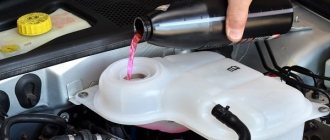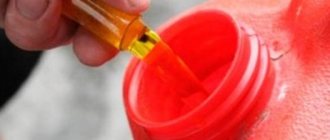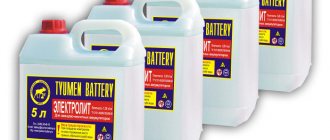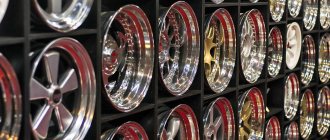In winter, a car operates under high load, this applies to both the engine and the suspension. It should be understood that winter is much more dangerous in operation and no one wants to encounter troubles in the cold. You may have noticed jerky behavior in cold weather or some other strange behavior - this is a clear sign of insufficient preparation.
In the article we will look at the main stages of preparation, because it takes too long to consider all the nuances and rarely does anyone correct all the little things. We will try to cover the little things at least superficially.
Tires
Every sane car enthusiast knows that with the arrival of winter it is necessary to “change the tires” and saving in this matter is unacceptable. This is due to the fact that already at +5°C, even on a dry road, grip deteriorates significantly, and at +3°C the tires turn into a piece of “stone” rubber and completely lose their elasticity.
Therefore, not only the safety of the motorist, but also the safety of the road users around him depends on the presence of winter tires.
On the eve of the cold season, you should purchase winter tires. It is best to opt for tires marked MS. In addition, experts recommend buying the narrowest tires within the limits allowed for your car. Tire treads must push the snow slurry down to the hard road surface, and the narrower the tires, the better they cope with this task.
Please note that the tread height must be at least 4 mm. You should also increase the tire pressure by 0.2 bar compared to how you inflate them in the summer.
The controversy over studded and non-studded tires continues. Experts recommend making a choice depending on operating conditions. If you mainly drive in an urban environment, where road services promptly clear the roads of snow and at most there is a slight icy crust on them, then you should choose tires without studs. And studded tires are best purchased by those who most often drive in the countryside, where the roads are mostly covered with snow and ice. This is due to the fact that on asphalt, if there are studs on the car, the braking distance increases significantly and the likelihood of skidding increases.
You cannot combine studded and non-studded tires, for example, install studded tires on the front wheels and regular winter tires on the rear wheels. This mix is dangerous even on clean asphalt, not to mention a slippery road surface.
The difference between street and garage storage of cars in winter
There are several opposing opinions about where it is better to store a car in winter: outside or in a garage, and if in a garage, then whether it should be heated. Each option has its advantages and disadvantages.
Advantages of garage storage:
- additional protection against theft;
- availability of a place for self-repair of a car, where you can also store tools and spare parts for the car;
- protection of the car from aggressive environmental influences.
If the car is in the garage in winter, the owner will not have to clear it of adhered snow every morning. However, he will be forced to take up a shovel to clear the entrance to the gate.
What to pay attention to when storing in a garage:
- the garage should be well ventilated;
- the optimal humidity in the room should not exceed 50%;
- In a closed, insulated garage, there is a high probability of corrosion processes.
If the garage is not heated and does not have good ventilation, it is better to park the car outdoors.
To minimize all possible risks associated with street storage of a car, you should choose the right place for winter parking.
Rules for storing a car on the street:
- It is best to park the car where you can watch it from the window of your house.
- At night, the area should be well lit.
- You should not leave your car under trees: falling branches, cones and bird droppings pose a threat.
- You should not park in a place where icicles and masses of wet and icy snow can form and fall.
It is necessary to choose a parking place from which you can always leave. It is worth carefully examining the area where the car is parked: if the wheels get into potholes, then when there is a thaw, water will begin to collect there, and when the temperature drops, the liquid can freeze and bind the wheels.
To avoid severe icing of the car while parked overnight, it is necessary to ventilate the interior in the evening and bring the temperature in it to ambient temperature.
Battery
The average lifespan of a car battery ranges from 3 to 5 years.
The older the battery, the more likely it is that it will not charge to its rated capacity. Therefore, you should not use it “to the last”, but it is worth purchasing a new one. For young batteries, before the cold season, you need to clean the terminals from oxidation products - white growths that appear on the contacts as a result of exposure to acids. You can clean them with a toothbrush and a small amount of baking soda, which must be diluted with water to form a thick sour cream or using a special lubricant. If necessary, the terminals must be properly crimped.
Then you need to check the amount of battery fluid. During hot weather, it often evaporates, so it should be replenished with distillate. This must be done carefully so that the water does not overflow. It is better to entrust this to specialists.
After this, the battery must be charged to its nominal capacity. This can be done directly in the car or using a wall charger. After charging, it is recommended to check the electrolyte density level. It should be no lower than 1.27 for central Russia and 1.29 for the northern regions. If the density level is lower, then it can be increased in service or the battery can be replaced.
If the battery has “spent the night” in severe frost, then a hot bath will help to defrost it. The device should be lowered into a bath filled with water so that it covers no more than two-thirds of it.
Take important things with you
A winter road is no joke, and it is impossible to predict what awaits around the bend and where you will have to make an emergency stop. In order to eliminate as many surprises as possible, make sure in advance that you always have the following in your trunk:
- Set of external starting wires. It will help to “light up” from another car in case of a battery failure.
- A tow rope if you have to pull your car out of impassable snowdrifts.
- Jack for emergency wheel replacement.
- Snow brush and rubber ice scraper. The first should be softer and smaller so as not to take up extra space in the trunk, and the second should have an elastic edge so as not to scratch the glass.
- A folding shovel, which will come in handy if the car stalls in deep snow.
- Anti-ice for quick glass cleaning. You can wipe foggy windows with paper towels or napkins.
- Antigel additive for diesel cars. It must be added to the gas tank before refueling to prevent the fuel from thickening in the cold.
- Thick winter mats under passengers' feet to absorb thawed snow from boots.
- And also throw work gloves, a hatchet, a hammer and a flashlight in the trunk - you never know what will happen and when.
Engine oil
Most often, oils are changed regardless of the season, but according to mileage.
However, due to the severity of Russian winters, experts recommend that you carefully consider the choice of oil that is filled in before winter. To prevent it from freezing, you should choose those varieties that have a lower viscosity index: 0W, 5W or 10W. To calculate the temperature of use, the thirty-five formula is used: 35 – viscosity index = freezing point of the oil.
For example, the viscosity index of motor oil is 5W, respectively, the freezing point will be equal to: 35 – 5W = -30°C.
For the northern regions of the country, it is best to use oils with a zero viscosity index. However, these varieties are found only among synthetic oils, so the following rule should be taken into account.
If you used mineral oil in the summer, you should not switch to synthetics. It is better to replace it with semi-synthetic oil. This is due to the fact that due to a sudden transition from mineral water to synthetics, oil seals may leak.
What would be the right choice for driving in winter – Velcro or studded tires: opinions of car enthusiasts
- “We give preference to studs”
“The choice of tires depends on the road surface. Some trails are constantly groomed and dry, while others are snowy and icy. My father rode both cleats and Velcro. As a result, in his opinion, driving on studded tires is much safer, since the studs will prevent skidding in the event of emergency braking. He also believes that tires without studs slip on the roads in winter. Personally, I installed Goodyear studded tires. At first, you could constantly hear the wheels touching the asphalt. Now there is no such problem: perhaps I’m used to it, or the brand is very good..." - “It all depends on the situation”
“I used to ride on Gislaved Nord Frost II studded tires. Now I bought Bridgestone MZ-02 Velcro. I can say that it all depends on the situation. Studded tires behave much better than Velcro on the roads. With it you can brake sharply in an emergency, and the spikes also allow you to climb any hill on a slippery surface. But Velcro doesn’t rattle, and it’s much more comfortable to ride if you avoid extreme situations.” - "To each his own"
“An experienced driver can drive with Velcro all winter. Personally, I drive the NF3 in both winter and summer. But during emergency situations on the roads, namely during heavy ice conditions, it is still better to give preference to studded tires. It will be very difficult to ride on the Velcro on steep, icy descents and ascents. In such cases, spikes are an irreplaceable thing.In those regions where there are harsh and cold winters (in the Urals), of course, it is better to drive on studded tires. Well, if you live in the south or western part of Russia, you can safely ride on Velcro. In these areas of the country it is very rare to find slippery roads in winter. My nephew lives in Tyumen, he has two geldings CLK and Gelen. He always drives on studded tires as a matter of principle and sees only advantages in this.”
- “People have been spoiled”
“15 years ago we drove on the same tires in winter and summer. And everyone was comfortable. Now they have come up with some kind of Velcro. I used to always drive on studded tires. Now I’ve been riding Velcro for the second year. I must say, if you follow the traffic rules, you can do without spikes.” - “Velcro can be dangerous”
“I used to drive an old Skoda with Velcro.” The car constantly skidded sharply on slippery roads. It is very dangerous. Now I also drive a Skoda, but with studded tires (from a company like Amtel). Despite the fact that the car rattles a lot on the asphalt, driving on ice is very comfortable.” - “Spikes hold up worse on asphalt”
I bought the car complete with used Pirelli Velcro. I was very pleased. It did not skid either during acceleration or braking. Now I bought Gudy Ice Navi. Also Velcro, but the impressions are so-so. The car needs to be constantly monitored; it behaves very unstable on the roads. The ABS system is activated immediately after pressing the pedal. In general, it's not all about the tires, but about the company.In winter, ice on the roads in the city is rare; mostly 80% is asphalt. On icy asphalt, studs are unstable, unlike Velcro. And if the car is all-wheel drive, definitely choose Velcro, you will be happy.”
Let's summarize our article. We have reviewed the basic rules of driving various types of cars. They will help you cope with emergencies and skidding on the roads
Most importantly, check your brakes and stopping distance before driving. It doesn't matter what drive type your car is
Always obey traffic rules, speed limits and distance from other vehicles. Avoid sudden maneuvers. This will help you drive safely in winter.
Process fluids
When preparing your car for winter, be sure to change the coolant to antifreeze. And for those car owners who added water or mixed different types of antifreeze, the tank must first be completely drained, otherwise in cold weather the remnants of these liquids will freeze. When choosing antifreeze, pay attention to its concentration, it should be approximately 60%. Exceeding this parameter is unacceptable, as this reduces its effectiveness.
For cars whose age has crossed the five-year mark, the entire cooling system must be flushed before the cold season. Residues of coolant in the tank or pipes can lead to the radiator simply bursting in winter.
After flushing the system, do not forget to fill in a special “moisture remover”. It will absorb and remove any liquids that remain in the system.
Windscreen wipers
Not all car owners know that there is a difference between summer and winter wipers. It is indicated on the packaging as the temperature of use. Therefore, even if the brushes work properly and do not leave streaks on the glass, you should check at what temperature they can be used. And if it is not large, then you should replace them with winter windshield wipers. They have a special sheathed frame part. They clean glass better due to their tighter fit to the surface. This is due to the fact that ice from slush accumulates in the frame and does not interfere with cleaning the windshield.
Change broken headlights
Properly functioning lighting is one of the key aspects of safe winter travel, as driving in daylight alone is unlikely to be possible. In the morning and evening, only bright headlights will save a car enthusiast, which means that the performance of the lighting cannot be ignored. Over time, the headlights begin to dim, become covered with dirt, scratches and weaken, so that any kilometer risks being their last. It is better to see the problem in advance and change the lamp, which is on its last legs.
Tip: Autumn is the best time to polish old headlights and replace faded xenon lights.
Brake system
Brake fluid should not be changed on the eve of winter, but as needed. With prolonged use, condensation accumulates in it, which causes wear of the pistons, which can lead to interruptions in the operation of the brake system not only in winter, but also in summer.
However, when preparing your car for winter, you need to pay attention to the balance of the brake boosters.
If the indicators differ, then during icy conditions this can cause uncontrolled skidding and accidents.
Replacing optics
First you need to diagnose the headlights, perhaps they are very dim or the bulbs are worn out. During snow, visibility is greatly deteriorated, the snow itself interferes with visibility, and if your headlights shine worse than necessary, then this promises a lot of inconvenience and danger. Mainly concerns the track.
It is rarely necessary to change the entire optics assembly; more often, replacement of lamps, reflector or simple polishing is sufficient.
Locks and seals
Another mandatory step in preparing a car for winter is the pre-season treatment of door seals and keyholes.
During severe cold weather, moisture accumulates on the seals, so they can freeze. When trying to open the door, the car owner may tear or deform them. To avoid this, you need to promptly treat them with silicone lubricants or antifreeze. Please note that if you use lubricant, it will last for the entire season, whereas with antifreeze you will have to lubricate the seals several times during the winter.
Before winter, you need to thoroughly lubricate all the locks with oil and spray them with a special water-repellent aerosol. This will prevent the locks from freezing. If you do not do this, then if the battery is discharged, you will not be able to open the door either using the central lock or the key.
In winter, after each visit to the car wash, do not forget to spray the locks with an aerosol with a water-repellent effect.
Body corrosion protection
The most vulnerable areas of the body may suffer from corrosion as a result of the harmful effects of external factors such as oxygen and water. This is the oxidation of a metal, which is a destructive process. At risk are hard-to-reach places, for example, seals or hidden holes in which liquid evaporates for a long time.
It is important to know how to treat your car for the winter to avoid damage from corrosion.
External body treatment products:
- Mastic - based on synthetic materials, bitumen or epoxy resins with rubber. Protect and have a soundproofing effect. Used after heating.
- Non-drying substances – have high elasticity, but do not protect against mechanical damage.
- Bitumen mixtures – including rubber, inhibitors. Used to prevent rust.
- Mixed bitumen – able to withstand low air temperatures (up to -60°C).
- Slate – suitable for processing the bottom of a car.
- Polymer - made on the basis of rubber and polyvinyl chloride. Has good adhesion to the surface. Used for application over primer.
- Liquid plastic - preferably used for the hood edge, wheel arches, sills. Such mixtures are mainly used as an additional method that enhances the effect of other remedies.
- Movil is an anti-corrosion mixture for joints, seams and other body surfaces. After drying, it turns into a protective layer similar to wax.
Fact! As an alternative to car body treatment, you can use lamination with anti-gravel, vinyl or polyurethane film. This coating can protect the surface from scratches and chips. However, for the bottom you need to use only mastic, spreading it over the entire surface.
The film also protects the paintwork from fading under the influence of ultraviolet rays. After application, the “film” protection does not harm the paint and varnish because it does not react chemically with the paintwork.
Thermal insulation
Car enthusiasts in the northern regions of the country should also consider additional thermal insulation of the interior and engine. For the engine compartment, there are special heat shields that fit over the radiator and engine “blankets” that cover the engines. To insulate the interior, there are also special screens that are mounted on the doors, bottom, roof and trunk partition.
Attention! You need to be extremely careful with so-called car blankets. Insulating accessories are not suitable for all cars and in some cases can cause a car fire.
Think about yourself
Things that won't take up much space, but are useful in difficult situations:
- warm blanket;
- woolen mittens and socks;
- a thermos with warm tea (or just boiling water);
- a convenient high-calorie snack that will give you strength (for example, dried fruits or nuts);
- extra charged cell phone battery.
Engine diagnostics
Experts say that car wear and tear occurs many times more intensely in winter than in summer. Therefore, before the season, you should check the performance of the motor, levers, suspension and hubs. Cold wind, snow and ice pieces wear away parts much faster, which can cause a serious accident.
To simplify engine starting, pre-start heaters can be installed. They come in two types:
- Autonomous . These heaters always maintain a high temperature and supply it to the cooling system when necessary.
- Electrical . Such heaters heat up the antifreeze only when the network is started.
Features of vehicle preparation for different types of fuel
Many car enthusiasts believe that in winter they should use gasoline with a higher octane number. For example, instead of 92, fill in 95. However, experts recommend continuing to use the gasoline or diesel fuel that is provided for your car brand.
However, there is still a difference between summer and winter gasoline and diesel fuel. It is related to the saturated vapor pressure indicator. It is he who is responsible for the quality of engine starting in winter. In summer types of gasoline and diesel fuel, the DNP indicator is approximately 80 kPa, and in winter types it is from 90 to 100 kPa.
As for cars running on gas, they also have a difference between winter and summer fuel. Winter gas contains much more propane than butane, while the ratio is not so striking in summer gas.
Gas and gasoline gas stations of serious brands in winter automatically change the saturated vapor pressure in all types of gasoline and the ratio of butane and propane for gas. Therefore, the only advice that can be given to car enthusiasts is to refuel at trusted gas stations, avoiding dubious brands.
Useful tips
In conclusion, we will share valuable tips that will help the reader properly prepare the car for frost:
- Carry an emergency kit with you, consisting of engine oil, tools, a flashlight, etc.
- Before winter, check all belts and pipes in the engine.
- Refill with fresh windshield washer fluid and change the windshield wipers from summer to winter.
- Always try to keep the tank full.
- Monitor antifreeze.
- Check the oil.
- Check the battery.
- Change your tires to winter ones and check their pressure.
Motorist winter kit
The minimum kit for driving in winter includes the following equipment:
- Anti-freeze for windshield washer.
- A small or collapsible snow shovel.
- Brush and scraper for cleaning the body from snow and ice.
- Silicone grease for processing seals.
- Start wires for lighting the car.
- Canister with spare fuel.
- Lock defroster and moisture-repellent spray. The first one is needed if the car owner did not treat the locks before the season or forgot to spray the locks with spray after washing.
- Towing rope.
- Gloves.
- For the northern regions of the country you will also need a bag of sand or gravel, snow chains and a hatchet.
Additional accessories
Car owners will benefit from additional accessories in winter that will save them in extreme situations.
First of all, you need to have a supply of all the necessary fluids, a spare tire, a shovel, scrapers and brushes for cleaning the windows from ice and snow, a towing rope, water-repellent aerosol, a flashlight, an additional set of wires in case of external starting of the engine (for “lighting up”), a set of spare fuses, as well as spare headlight bulbs.
Water repellent spray for locks
In winter, drivers may encounter a problem such as freezing of doors when there is a sharp change in temperature from thaw to freezing. The use of a water-repellent spray prevents moisture from entering the lock mechanism. It is also recommended to treat keyholes with this aerosol after each car wash.
Sizebunny
The size of the de-icer, or glass defroster, allows you to remove ice from windshields as much as possible, prevents the re-formation of ice and does not require additional cleaning afterward.
Automatic engine warm-up
In winter, it is difficult to start a car without an engine preheater. The device is designed to heat up the coolant. Using automatic heating increases the comfort of operating the machine in cold weather and saves time.
According to the principle of operation, pre-starting motors are divided into two types:
- electrical;
- autonomous.
Electric heaters need to be connected to a 220 volt power supply. The principle of their operation is the same as that of a conventional boiler that heats the coolant.
Autonomous - they use the fuel of the car itself as energy. They do not depend on external sources, so they are more convenient, but they are also more expensive.
Thermal bag for battery
A thermal bag, or thermal case for a battery, is a soft, sealed thermos that does not allow cold to pass through. The case maintains temperatures from –15 to +30 °C.
The battery heats up while the engine is running. The thermal case creates a thermal bath around it, forming a vacuum. This allows the battery to be in a comfortable atmosphere and extends its service life.
Battery plugs
It would also be a good idea for car owners to have a device for measuring battery charge. This is the load fork.
First of all, those drivers whose car already has a good mileage should check the state of charge of the battery.
